| The World's Weirdest Sharks and Rays |
| Written by Jonathan C. Wojcik - Photo credits unknown or from public news articles unless otherwise noted. If you know their sources and need them credited or removed, please e-mail me. |
| The Chimaeras |
Also called "ratfish," these primitive creatures are distinct from the sharks and rays in their
own special order, the Chimaeriformes, most abundant in the deepest waters. Instead of
sharp teeth, their jaws are equipped with thick plates that can grind apart the shells of crabs
and mussels that they root from the mud. Many species have a lethally venomous spine
before the dorsal fin, but encounters with humans are incredibly rare.
own special order, the Chimaeriformes, most abundant in the deepest waters. Instead of
sharp teeth, their jaws are equipped with thick plates that can grind apart the shells of crabs
and mussels that they root from the mud. Many species have a lethally venomous spine
before the dorsal fin, but encounters with humans are incredibly rare.
Sharks, stingrays and other members of the class Chondrichthyes are among the oldest
vertebrates alive today, having prowled the seas long before the age of the dinosaurs and even
pre-dating the development of bone, having skeletons comprised entirely of flexible cartilage.
These "primitive" yet highly successful fish are among the top predators of every marine
environment, and many have remained unchanged for millions of years.
Key to the success of these animals is their powerful electroreception, the ability to "feel" the
electrical fields of other living things. This quality is absent from most other animal groups, and
sharks in particular are the most electrically sensitive animals known to man.
vertebrates alive today, having prowled the seas long before the age of the dinosaurs and even
pre-dating the development of bone, having skeletons comprised entirely of flexible cartilage.
These "primitive" yet highly successful fish are among the top predators of every marine
environment, and many have remained unchanged for millions of years.
Key to the success of these animals is their powerful electroreception, the ability to "feel" the
electrical fields of other living things. This quality is absent from most other animal groups, and
sharks in particular are the most electrically sensitive animals known to man.
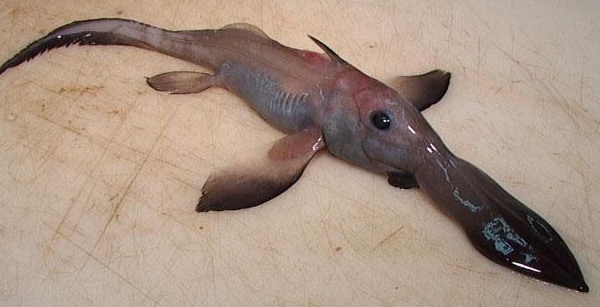
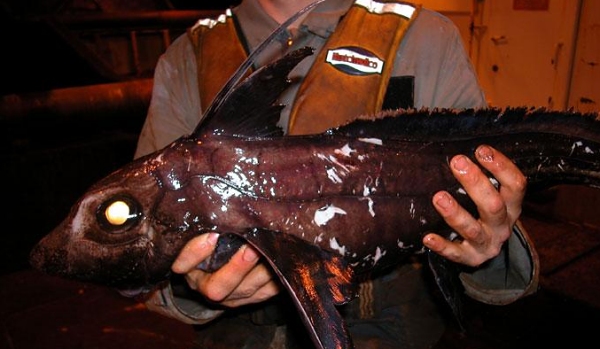
Some species, such as this long-nosed chimaera, have a greatly enlarged snout that
provides extra room for electroreceptive pores, which they wave above the sea floor like a
metal detector.
provides extra room for electroreceptive pores, which they wave above the sea floor like a
metal detector.
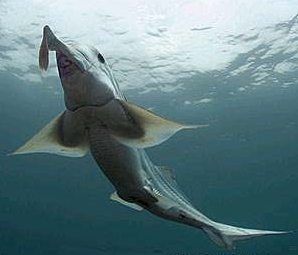
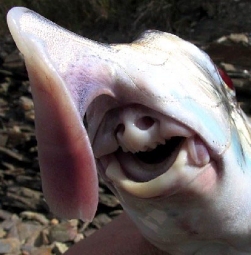
While Chimaeriformes are primarily deep-water fish, a few can be found as little as a few
hundred meters below the sea's surface, and migrate to even shallower waters when the
time comes to spawn. The "ghost shark" or "elephant shark" is one such Chimaera, with
what may be one of the most curious faces in the animal kingdom.
hundred meters below the sea's surface, and migrate to even shallower waters when the
time comes to spawn. The "ghost shark" or "elephant shark" is one such Chimaera, with
what may be one of the most curious faces in the animal kingdom.
| The Megamouth Shark |

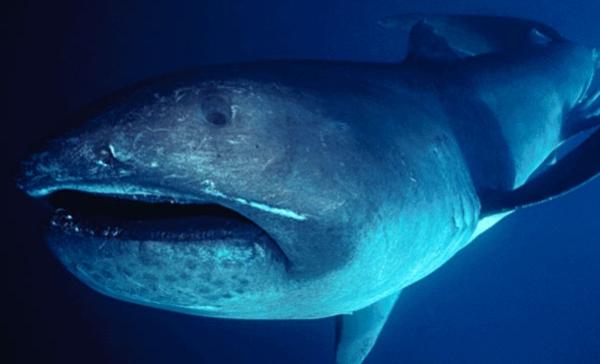
Megachasma pelagios is considered one of the rarest sharks in the world, and to some,
one of the strangest. Its head and mouth are unusually large even for a body that
approaches twenty feet, but like the basking shark and whale shark, its diet consists mostly
of plankton and the tiniest fish. Unlike any other shark, its mouth is encircled by tiny,
luminescent spots that may serve as lures.
one of the strangest. Its head and mouth are unusually large even for a body that
approaches twenty feet, but like the basking shark and whale shark, its diet consists mostly
of plankton and the tiniest fish. Unlike any other shark, its mouth is encircled by tiny,
luminescent spots that may serve as lures.
Rarely seen by man but thought to be quite abundant, the mysterious Mitsukurina owstoni
was once known as the "tengu" shark, after long-nosed crow spirits from Japanese folklore.
A juvenile specimen filmed in late 2008 is the first of its kind ever captured on video, and
demonstrates the animal's most striking feature as it snaps at the arm of a diver:
was once known as the "tengu" shark, after long-nosed crow spirits from Japanese folklore.
A juvenile specimen filmed in late 2008 is the first of its kind ever captured on video, and
demonstrates the animal's most striking feature as it snaps at the arm of a diver:
| The Goblin Shark |
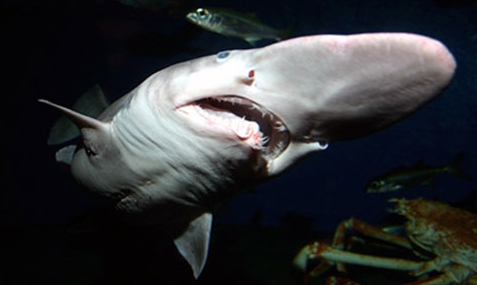
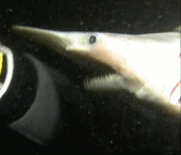
Though reaching nearly ten feet in length at maturity, the goblin shark feeds mainly upon
animals small enough to swallow whole, using its uniquely extensible jaws as a vacuum-like
mechanism. As such, their jaws are far too feeble to bite pieces out of larger prey, and
would pose no significant danger to a human swimmer.
animals small enough to swallow whole, using its uniquely extensible jaws as a vacuum-like
mechanism. As such, their jaws are far too feeble to bite pieces out of larger prey, and
would pose no significant danger to a human swimmer.
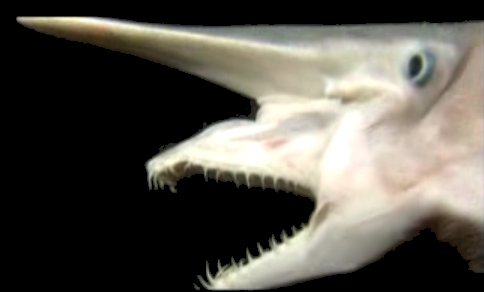
| Cookie-cutter Sharks |
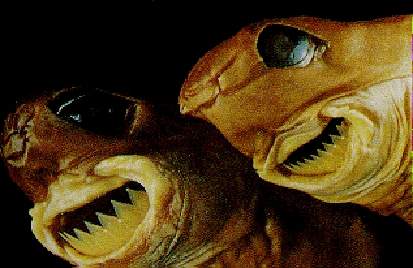
Forget the Great White, the Bull Shark or the Hammerhead; Isistius brasiliensis is barely
twenty inches in length, but preys upon creatures from the tiniest crustacea to the largest
whales. Dwelling in the dark abyss by day and ascending to the surface at night, its body
dimly glows except for one small patch near its head, a contrast that disguises its shape and
makes it appear much smaller than it actually is, allowing it to make a surprise attack in
plain sight or attract larger predators right up to its eager little jaws...and what jaws they are!
twenty inches in length, but preys upon creatures from the tiniest crustacea to the largest
whales. Dwelling in the dark abyss by day and ascending to the surface at night, its body
dimly glows except for one small patch near its head, a contrast that disguises its shape and
makes it appear much smaller than it actually is, allowing it to make a surprise attack in
plain sight or attract larger predators right up to its eager little jaws...and what jaws they are!
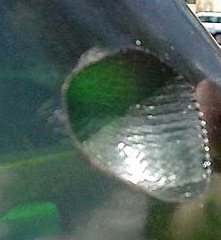
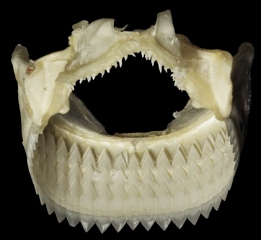
To prey on bigger animals, the shark simply sinks its bizarre jaws deep into their skin, twists
its little body and carves out a perfect skin-biscuit like H.P. Lovecraft's ice cream scoop.
Fish, sharks, seals, dugongs, whales of all sizes and yes, even human beings have been
found with telltale scoop-marks in their flesh. Alluded to "mosquitoes of the sea" by one
biologist, the sneaky little bastards have adapted to prey upon whatever they want,
whenever and wherever they get hungry. They've even taken bites out of rubber submarine
equipment, forcing the navy to install special fiberglass covers and giving us a wonderful
example of what these guys will do so your soft, flabby thighs if they catch you in the water
one night:
its little body and carves out a perfect skin-biscuit like H.P. Lovecraft's ice cream scoop.
Fish, sharks, seals, dugongs, whales of all sizes and yes, even human beings have been
found with telltale scoop-marks in their flesh. Alluded to "mosquitoes of the sea" by one
biologist, the sneaky little bastards have adapted to prey upon whatever they want,
whenever and wherever they get hungry. They've even taken bites out of rubber submarine
equipment, forcing the navy to install special fiberglass covers and giving us a wonderful
example of what these guys will do so your soft, flabby thighs if they catch you in the water
one night:
| Torpedo Rays |
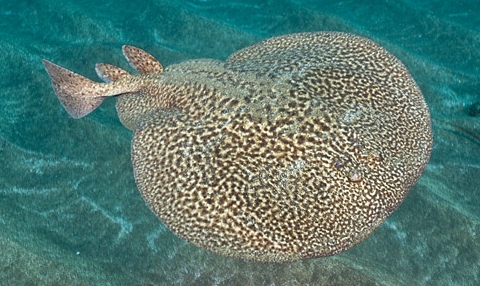
While many rays are armed with a venomous stinger at the base of the tail, the
Torpediniformes hunt and defend themselves with an electrical discharge of up to 220
volts in some of the larger species. Though not quite as powerful as the Amazon's electric
eel (500 volts) this shock can easily paralyze a human being, earning them such common
named as "crampfish" and "numbfish." The ancient Greeks even used these rays as an
early form of anesthetic, applying the fish live to dull the pain of childbirth or surgery.
This flying saucer of the sea is the only animal here that cannot be found in the deep sea
abyss.
Torpediniformes hunt and defend themselves with an electrical discharge of up to 220
volts in some of the larger species. Though not quite as powerful as the Amazon's electric
eel (500 volts) this shock can easily paralyze a human being, earning them such common
named as "crampfish" and "numbfish." The ancient Greeks even used these rays as an
early form of anesthetic, applying the fish live to dull the pain of childbirth or surgery.
This flying saucer of the sea is the only animal here that cannot be found in the deep sea
abyss.
| Photo by Andy Murch |
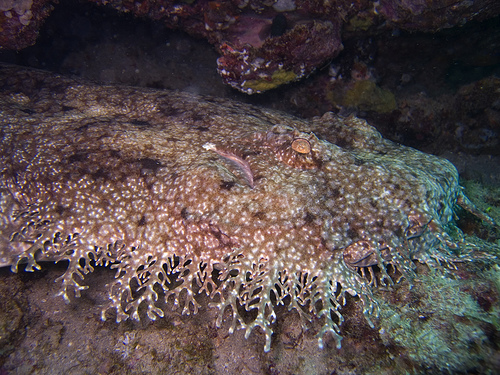
| The Carpet Sharks or "Wobbegongs" |
There are around eight species of Orectolobidae, found in warm, shallow waters from
Australia to Japan. Often called "wobbegongs," ("shaggy beards" in Aboriginal dialect) their
mottled coloring, flattened bodies and weedy coloring allow them to hide in ambush on the
ocean floor, waiting to suck unwary prey into their vacuum-like throats. There is even
evidence that their seaweed-like growths serve to attract small fish like the Megamouth's
glow-spots.
Though not large enough to prey upon humans, a Wobbegong has many small, sharp teeth
and a powerful bite. If stepped on or otherwise provoked, they are said to clamp down and
hang on like a bear-trap until forcibly removed.
Australia to Japan. Often called "wobbegongs," ("shaggy beards" in Aboriginal dialect) their
mottled coloring, flattened bodies and weedy coloring allow them to hide in ambush on the
ocean floor, waiting to suck unwary prey into their vacuum-like throats. There is even
evidence that their seaweed-like growths serve to attract small fish like the Megamouth's
glow-spots.
Though not large enough to prey upon humans, a Wobbegong has many small, sharp teeth
and a powerful bite. If stepped on or otherwise provoked, they are said to clamp down and
hang on like a bear-trap until forcibly removed.
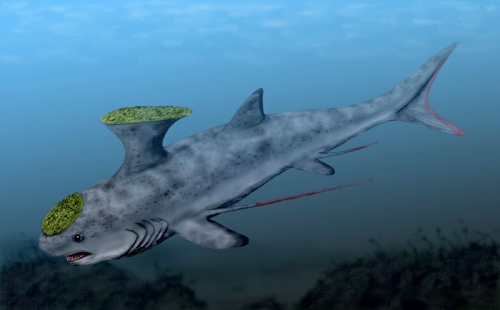
| Stethocanthus |
Sadly no longer with us, these prehistoric sharks were among several ancient species of
shark to have a...well...they had sort of a...thing. What is that?!
Resembling a barbed, brush-like platform, the purpose of this highly modified dorsal fin
remains mysterious. Scientists have speculated that it could have been used in
self-defense, hunting or a mating ritual, but since that's what everything in nature is for, we
basically haven't the foggiest. Some have even theorized that it attached itself to larger
sharks in a remora-like fashion, though this interesting idea is generally dismissed.
Mating may be the most likely of its uses, since only male skeletons have been found with
the appendage...but how and why they would use this funky doohickey for foreplay is an
even bigger mystery.
shark to have a...well...they had sort of a...thing. What is that?!
Resembling a barbed, brush-like platform, the purpose of this highly modified dorsal fin
remains mysterious. Scientists have speculated that it could have been used in
self-defense, hunting or a mating ritual, but since that's what everything in nature is for, we
basically haven't the foggiest. Some have even theorized that it attached itself to larger
sharks in a remora-like fashion, though this interesting idea is generally dismissed.
Mating may be the most likely of its uses, since only male skeletons have been found with
the appendage...but how and why they would use this funky doohickey for foreplay is an
even bigger mystery.
| Helicoprion |
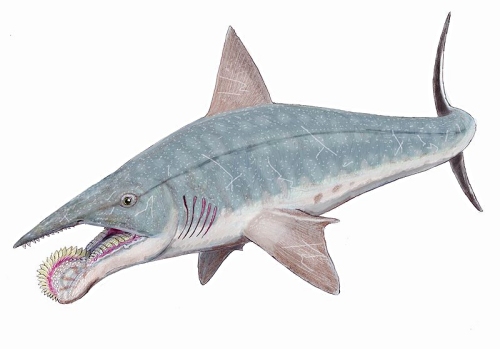
A far bigger mystery than Stethocanthus, Helicoprion is an extinct species known only from
fossils of a bizarre "tooth-whorl," a snail-like coil of shark teeth up to three feet across. Many
fossils of these whorls have been found, but never a complete skull, leaving everything else
about the creature to our own imagination. We haven't a clue how these freaky tooth
structures could have been used or even how large the rest of the animal may have been,
but the whorl size implies a fairly massive sea-monster.
In early reconstructions, it was hypothesized that the whorl could unravel and "whip" at the
shark's prey, though it was more likely a solid appendage that may have been able to crack
open shelled mollusks.
fossils of a bizarre "tooth-whorl," a snail-like coil of shark teeth up to three feet across. Many
fossils of these whorls have been found, but never a complete skull, leaving everything else
about the creature to our own imagination. We haven't a clue how these freaky tooth
structures could have been used or even how large the rest of the animal may have been,
but the whorl size implies a fairly massive sea-monster.
In early reconstructions, it was hypothesized that the whorl could unravel and "whip" at the
shark's prey, though it was more likely a solid appendage that may have been able to crack
open shelled mollusks.